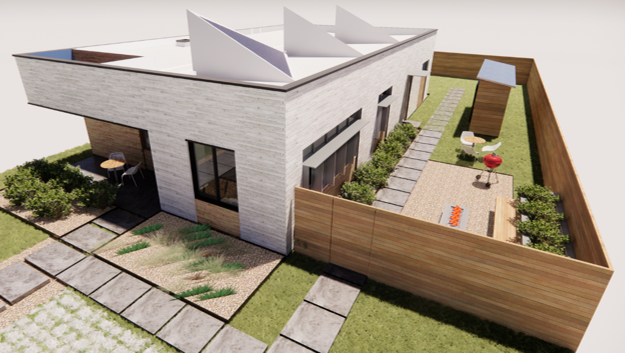
Texas A&M University
Team Name: Solar Texas
Build Location: College Station, Texas
This multidisciplinary team will demonstrate how affordable housing can combine sustainability and function in this 1,580 ft2 structure in a college town.
Project Summary
Solar Texas is an interdisciplinary team of students and faculty from all departments in the College of Architecture at Texas A&M University (TAMU), in partnership with the Brazos County non-profit Habitat for Humanity, that brings resources to the working poor, provides hands-on, interprofessional experiential learning for the students, and skill development to the workers. The TAMU goal is to design/build a safe, attainable, high-performance, carbon-neutral, net-zero, energy-generating workforce house while fostering community development, lifelong learning, health, wellness, and financial stability for "economically vulnerable" classes to break their cycle of poverty and amplify quality of life, health, and well-being.
Design Philosophy
With the mounting threats from a changing climate, there is a need to build affordable homes that are also equipped for passive survivability. The strategy of the Solar Texas team has been to address the ten categories of the Solar Decathlon competition while also incorporating twelve elements that can enhance passive survivability:
- Solar Texas
- Solar Integration
- Rainwater Harvesting
- Affordable + Attainable housing
- Butterfly Roof
- Carbon Footprint Reduction
- Passive Survivability
- Drought Tolerant Landscaping
- Aging-in-Place
- Texas Vernacular
- Circadian Rhythms
- User Experience
We acknowledge that while the above twelve elements (inspired by Texas A&M’s 12th-man rallying cry) can often be attained at a relatively high first cost, the challenge is to realize them at a price point affordable to households earning a median income. Working with Habitat for Humanity to build homes for underserved communities has spotlighted the complexity of the challenge. The intensity of the Solar Decathlon competition has revealed to participants that, rather than a “one-off” effort, the Solar Texas team needs to engage in long-term continuous improvement to incorporate innovative design, equipment, and material strategies to make passive survivability a realistic possibility for all.
Market Analysis
The lack of affordable housing is one of our nation's most pressing crises. Solving this requires a multi-pronged approach that disrupts current design, supply, delivery, and policy systems, breaks down silos within the design, social, and engineering sciences, and leads to research and practice resulting in sustainable and equitable development.
The Solar Texas team developed a Life Cycle Analysis of the area's most recently constructed Habitat for Humanity projects as a baseline for comparison. The team aims to deliver a scalable prototype for the organization to offer the highest possible quality product optimized for energy efficiency and resource sustainability.
Key Features:
- Passive solar/lighting
- 3D-printed, FEMA-compliant safe room
- Affordable housing
- Deconstruction through disassembly.
